「建议收藏」第一人称视角带你走进 Vue 源码世界
Posted 小生方勤
tags:
篇首语:本文由小常识网(cha138.com)小编为大家整理,主要介绍了「建议收藏」第一人称视角带你走进 Vue 源码世界相关的知识,希望对你有一定的参考价值。
前言
本文不引战,成熟的人应该脱离框架的范畴,而不是纠结谁更好或者谁更不好。有道是黑猫白猫,抓到老鼠就是好猫。
所以本文会带大家读源码。简单易懂,大佬小白都能看明白。并收获益处。
从 new 一个 Vue的实例粗来开始
准备工作: chrome 打开 Vue github 地址[1]
> cd 「你的路径」
> git clone https://github.com/vuejs/vue.git
> code vue (ps: 此命令为用VS code 打开 vue 项目)
复制代码看一下vue 项目的目录结构:
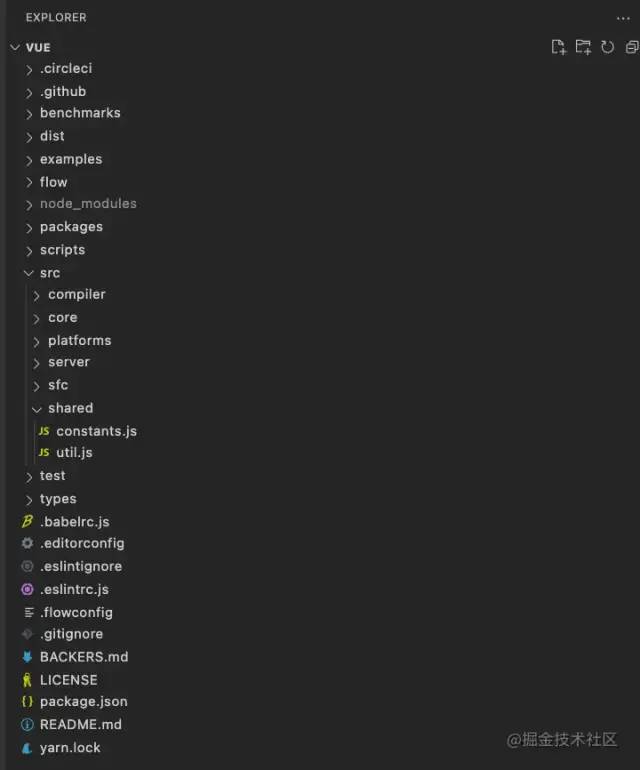
哇,结构很清晰噢!好像莫名的木有那么复杂嘛(为分析源码做心理建设)
全局安装 serve:
> npm i -g serve
Or
> yarn global add serve
> serve .
复制代码So you shoud open in: localhost:5000
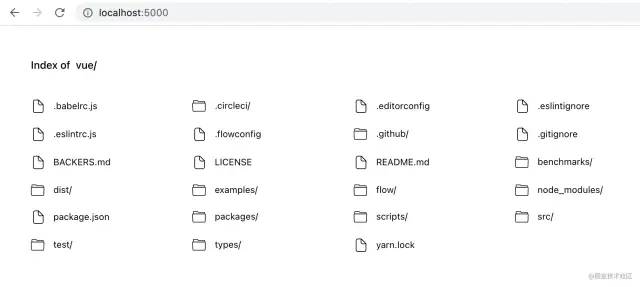
咦~ 项目的目录结构就在浏览器可视化了。
点击 examples ,再找到 markdown, 此时你的url是 http://localhost:5000/examples/markdown/[2]
哇哦,可以玩了。例如:

咦~ 左边写markdown 语法,右边就实时展示粗来了?No,这个不重要。重要的是,代码!
<!DOCTYPE html>
<html lang="en">
<head>
<meta charset="utf-8">
<title>Vue.js markdown editor example</title>
<link rel="stylesheet" href="style.css">
<script src="https://unpkg.com/marked@0.3.6"></script>
<script src="https://unpkg.com/lodash@4.16.0"></script>
<!-- Delete ".min" for console warnings in development -->
<script src="../../dist/vue.min.js"></script>
</head>
<body>
<div id="editor">
<textarea :value="input" @input="update"></textarea>
<div v-html="compiledMarkdown"></div>
</div>
<script>
new Vue(
el: #editor ,
data:
input: # hello
,
computed:
compiledMarkdown: function ()
return marked(this.input, sanitize: true )
,
methods:
update: _.debounce(function (e)
this.input = e.target.value
, 300)
)
</script>
</body>
</html>
复制代码细看我们的 script 标签, new Vue(...) 是不是开始有点东西了?
再
<!DOCTYPE html>
<html lang="en">
<head>
...
</head>
<body>
<!-- template for the modal component -->
<script type="text/x-template" id="modal-template">
...
</script>
<!-- app -->
<div id="app">
<button id="show-modal" @click="showModal = true">Show Modal</button>
<!-- use the modal component, pass in the prop -->
<modal v-if="showModal" @close="showModal = false">
<!--
you can use custom content here to overwrite
default content
-->
<h3 slot="header">custom header</h3>
</modal>
</div>
<script>
// register modal component
Vue.component( modal ,
template: #modal-template
)
// start app
new Vue(
el: #app ,
data:
showModal: false
)
</script>
</body>
</html>
复制代码这个栗子的功能很简单,就是页面上一个按钮,点击按钮会弹出一个框。你大概会觉得有点无聊,没关系,马上开始搞事情。
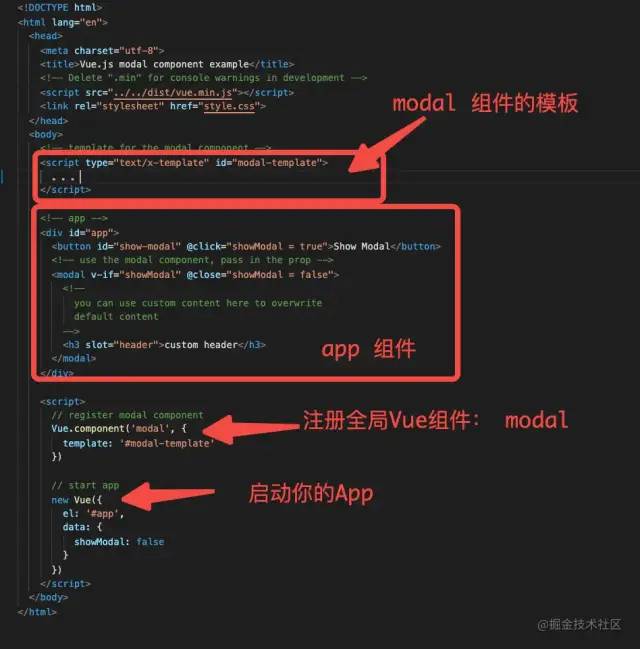
现在,你把 template for modal 那个script里的标签删掉,在点击页面上那个按钮。
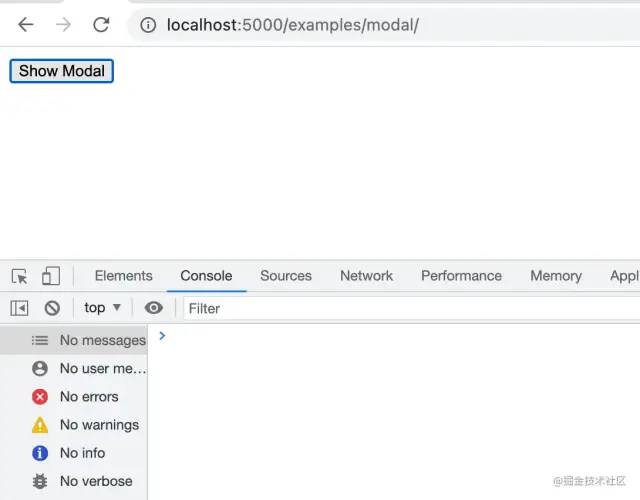 页面上即没有框弹出来,控制台也木有提示任何报错信息。同样,你干掉 注册全局Vue组件,得到的结果是 页面内容有变化,但依然木有出现弹框。
页面上即没有框弹出来,控制台也木有提示任何报错信息。同样,你干掉 注册全局Vue组件,得到的结果是 页面内容有变化,但依然木有出现弹框。

那么,只根据以上的尝试,总结以下几点:
一个页面就是一个 Vue 的实例。因为 有标准的
new语法如果页面要使用其它组件(app 代码之外的组件),必须要先注册
script 标签里居然写了 类似 html 的标签(例如 div),那肯定是要编译成正在可执行的代码
废话不多说,加几行代码看看。
const app = new Vue(
el: #app ,
data:
showModal: false
)
console.log( Vue.component: ,Vue.component)
console.log( Vue: ,Vue, new Vue: , app)
复制代码看图:
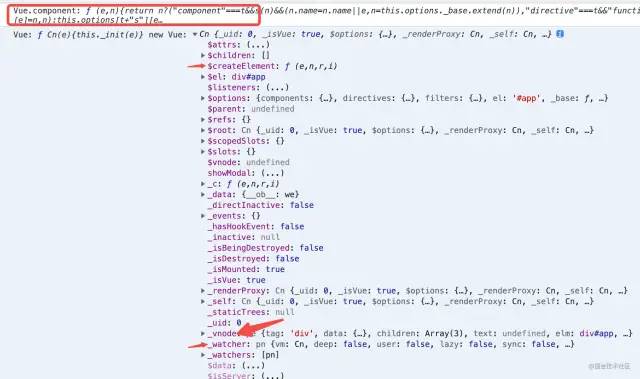
哇!打印出来的结果令人欣喜!你看到了什么??咱就抛开以往的知识,你觉得你认识哪几个单词?
先看 Vue.component 的打印结果。
明显,这是个 function,并且直接return 了一个 类似于经历了判断语句后的...结果?(图中红框表示)
入参好像暂时看不出什么,先暂留。
再看 new Vue(...) 的打印结果.
Vue 本身也是个 function
Vue 的实例 挂了很多属性,其中有些比较眼熟
vnode:猜测是虚拟DOM?
$createEmelemt: 这tm不是创建节点的意思?
_watcher: 这个单词监听的意思?
下一步:打个断点!如图
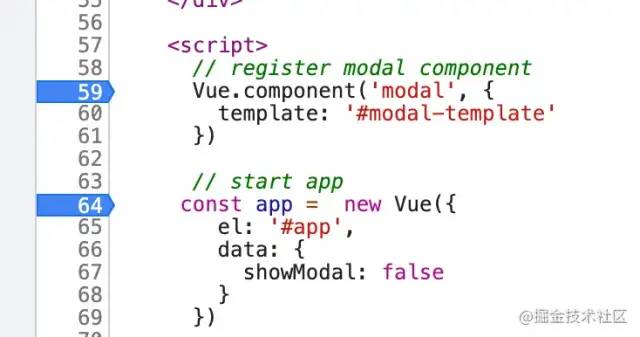

然后页面刷新,代码停在了。你会发现代码会经过 emptyObject、Vnode、Observer、Watcher处(因为我打好断点了,你可以根据上图自行找到并打好断点)。
最终,你会到这里。
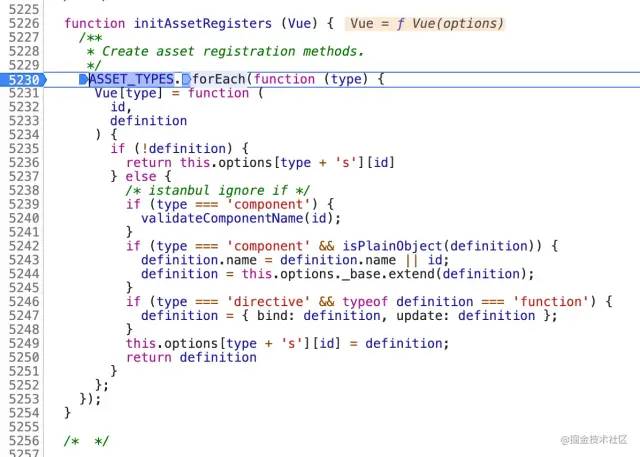
有木有觉得这段代码和上面哪里看到的很像?对!就是console 打印出来的 Vue.component .
破案了!终于找到看源码的入口了!!
冷静一下,先想想我们如何顺利的进入源码世界
你写Vue,你会看到哪些东西?咱就从最简单的(所见即所得)开始。
模板编译
将 template 转换为 渲染函数,也就是我们常说的render 。(React 当中也有 render 函数的概念,但它们不是一个东西,有一样也有区别)
// 此为 我们在 template 中 使用(写)的 HTML标签语法内容,
<button id="show-modal" @click="showModal = true">Show Modal</button>
复制代码那,其对应的render函数是什么?
render(h)
return h(
button ,
on:
click: ()=> this.showModal = true
,
Show Modal
)
复制代码啊 哈?你问我 那个 h , 那个 on 是什么东西?哎呦,我好像一下子没刹住,车开远了。没事,后面会解释(虚拟 DOM) 。至于如何证明模板编译最终是个render,其实你在webpack打包后的文件里稍微找一下便一目了然了。我们的.vue 文件就会被转化成render函数(通过 vue-loader)。
先来个小证明:render函数 到底是个什么东西。加行代码:
// register modal component
Vue.component( modal ,
template: #modal-template
)
// start app
const vm = new Vue(
el: #app ,
data:
showModal: false
)
console.log( render: ,vm.$options.render)
复制代码这句console 打印出了什么?如图:
那么,这件事情是在哪里处理的?源码位置:/vue-dev/src/platforms/web/entry-runtime-with-compiler.js
ps: 只截取部分源码代码, 关键位置我用中文注释了。
忽略代码:code ...
// 只截取部分源码
Vue.prototype.$mount = function (
el?: string | Element,
hydrating?: boolean
): Component
el = el && query(el) // 获取传入的el对象
/* istanbul ignore if */
/* el不可以是 body 和 html对象 */
if (el === document.body || el === document.documentElement)
process.env.NODE_ENV !== production && warn(
`Do not mount Vue to <html> or <body> - mount to normal elements instead.`
)
return this
const options = this.$options
// resolve template/el and convert to render function
// 将template/el 转成 render 函数。render挂在this.options 身上
if (!options.render) // 如果没有render属性,则 想办法 搞一个 render 函数
let template = options.template
if (template)
if (typeof template === string )
// code ...
template = idToTemplate(template) //该方法返回 el 的innerHTML
// code ...
else if (template.nodeType) // nodeType 是代表 template 和 el 是一样的。
template = template.innerHTML // 如果模板是element ,拿template的 innerHTML
else
if (process.env.NODE_ENV !== production ) // 啥也不是,非法
warn( invalid template option: + template, this)
return this
else if (el)
template = getOuterHTML(el); // 没有template,就用el的 outerHTML 作为模板
if (template) // 好的,经过以上处理,这时候肯定有模板了!
/* istanbul ignore if */
if (process.env.NODE_ENV !== production && config.performance && mark)
mark( compile )
// 敲黑板,划重点!! 此处 compileToFunctions 把 template 转换成 render 函数
const render, staticRenderFns = compileToFunctions(template,
// code ...
, this)
options.render = render
options.staticRenderFns = staticRenderFns
/* istanbul ignore if */
//code...
// 最终,要渲染DOM了。
return mount.call(this, el, hydrating)
复制代码稍微小结一下(new Vue(...) 到底干了什么):
最终目标是为了渲染真实DOM$mount要把template/el转化成render
先判断
this.$options身上有无render方法,若没有则需要转化template不存在则转化el
递归调用mount,并且矫正 this指向(必须一直指向Vue)
咦~ 太啰嗦了。总结成一句话就是:要保证Vue.$options.render方法是存在的。因为要计算VDOM。
回到开始,那render函数打印出来到底是个什么东西?如图:

我把代码format一下:
(function anonymous(
)
with (this)
return _c(
div ,
attrs: "id": "app" ,
[_c(
button ,
attrs: "id": "show-modal" ,
on: "click": function ($event) showModal = true
,
[_v("Show Modal")]
),
_v(" "),
(showModal)
?
_c( modal ,
on: "close": function ($event) showModal = false
,
[
_c( h3 ,
attrs: "slot": "header" , slot: "header" ,
[_v("custom header")]
)]
)
:
_e()],
1)
)
复制代码看得出,转化后的render函数其实就是个匿名函数(不是闭包)。其中 _c 方法其实就是 上述 所说的 h(啪!这是个误会,很容易被人误会。_c 就是 h ?)。
这里还有个小点,就是为什么会有 showModal ? _c : _e ? 它代表什么?哈哈,我把模板代码写出来看看。
<div id="app">
<button id="show-modal" @click="showModal = true">Show Modal</button>
<!-- use the modal component, pass in the prop -->
<modal v-if="showModal" @close="showModal = false">
<!--
you can use custom content here to overwrite
default content
-->
<h3 slot="header">custom header</h3>
</modal>
</div>
复制代码对,你猜的没错。v-if="showModal" 就是 showModal ? _c : _e , 而且是DOM 有和无的差别。
ps: 有人想问 with (this) 是个什么意思了。它的意思是,在with的作用域内,this为该域的最高级别的对象。也就是在with的作用域内的“window”, 访问 _c、_e等 会默认找至 with。
然而,根据常识,一般 _x 这种单字母格式的方法一般都在 core 目录下,Vue 也不例外。
_c:
/src/core/instance/render.js_v/_s 等 :
/src/core/render-helpers/index.js
so, 有必要找到定义 _c 的方法的位置。上源码:
export function initRender (vm: Component)
vm._vnode = null // the root of the child tree
vm._staticTrees = null // v-once cached trees
const options = vm.$options
const parentVnode = vm.$vnode = options._parentVnode // the placeholder node in parent tree
const renderContext = parentVnode && parentVnode.context
vm.$slots = resolveSlots(options._renderChildren, renderContext)
vm.$scopedSlots = emptyObject
// bind the createElement fn to this instance
// so that we get proper render context inside it.
// args order: tag, data, children, normalizationType, alwaysNormalize
// internal version is used by render functions compiled from templates
vm._c = (a, b, c, d) => createElement(vm, a, b, c, d, false) // 1
// normalization is always applied for the public version, used in
// user-written render functions.
vm.$createElement = (a, b, c, d) => createElement(vm, a, b, c, d, true) // 2
// $attrs & $listeners are exposed for easier HOC creation.
// they need to be reactive so that HOCs using them are always updated
const parentData = parentVnode && parentVnode.data
/* istanbul ignore else */
if (process.env.NODE_ENV !== production )
defineReactive(vm, $attrs , parentData && parentData.attrs || emptyObject, () =>
!isUpdatingChildComponent && warn(`$attrs is readonly.`, vm)
, true)
defineReactive(vm, $listeners , options._parentListeners || emptyObject, () =>
!isUpdatingChildComponent && warn(`$listeners is readonly.`, vm) // 3
, true)
else
defineReactive(vm, $attrs , parentData && parentData.attrs || emptyObject, null, true)
defineReactive(vm, $listeners , options._parentListeners || emptyObject, null, true)
复制代码请仔细看三个点, 代码中为加了数字标识。
定义 vm._c , 通过调用
createElement得到,其传入的最后一个参数为false。定义 vm.$createElement , 通过调用
createElement得到,其传入的最后一个参数为 true。isUpdatingChildComponent
小结一下:
vm._c 和 vm.$createElement 其实是一个东西,只不过处理 children 的方式不一样。(暂时不细说)
正式环境
production模式下,是不会去判断当前子组件是否正在更新,因为再去比较vm是需要一笔开销的。但开发环境就无所谓了,甚至还需要去做对比。因为dev 模式下,vm的体积是要比 production 大很多。
再看下 /src/core/render-helpers/index.js。这个看了之后,估计就能清晰很多了。
/* @flow */
//code ...
import ...
//code ...
export function installRenderHelpers (target: any)
target._o = markOnce
target._n = toNumber
target._s = toString
target._l = renderList
target._t = renderSlot
target._q = looseEqual
target._i = looseIndexOf
target._m = renderStatic
target._f = resolveFilter
target._k = checkKeyCodes
target._b = bindObjectProps
target._v = createTextVNode
target._e = createEmptyVNode
target._u = resolveScopedSlots
target._g = bindObjectListeners
target._d = bindDynamicKeys // 1
target._p = prependModifier
复制代码看,是不是清晰了很多。原来那么多_开头的函数都是在这被赋予的。 其中看下 bindDynamicKeys, 是的,你想得没错,你用 v-for 的时绑定的key 就是它完成的!(此处求源码打脸,我就不翻了……)
emmm, 好像前面的栗子还出现了 _v 方法,还是得解释一下 createTextVNode 方法。
path: src/core/vdom/vnode.js
// code...
export const createEmptyVNode = (text: string = ) =>
const node = new VNode()
node.text = text
node.isComment = true
return node
export function createTextVNode (val: string | number)
return new VNode(undefined, undefined, undefined, String(val))
// code...
复制代码唉,这没啥好说的了。就是有个 VNode类,可以new 出 空的vnode(虚拟节点)和 文本类型的vnode。至于vnode可以访问哪些属性和方法,你可以继续追根溯源……
这里,为了让大家能更深刻的理解html -> render 的过程,给个好玩的地址:template-explorer[3]
Q: 我们知道 template 最终也是要转化成 js 的,不然浏览器咋识别?那 template是如何转化成 最终的js的?答:template -> AST -> 优化后的AST -> render
好吧,继续上源码。path: /src/compiler/index.js
/* @flow */
import parse from ./parser/index
import optimize from ./optimizer
import generate from ./codegen/index
import createCompilerCreator from ./create-compiler
// `createCompilerCreator` allows creating compilers that use alternative
// parser/optimizer/codegen, e.g the SSR optimizing compiler.
// Here we just export a default compiler using the default parts.
export const createCompiler = createCompilerCreator(function baseCompile (
template: string,
options: CompilerOptions
): CompiledResult
const ast = parse(template.trim(), options) // template -> AST
if (options.optimize !== false)
optimize(ast, options) // AST -> 优化后的AST
const code = generate(ast, options) // 优化后的AST -> code.render
return
ast,
render: code.render, // 这个render 是 string, 使用时需要转化成function
staticRenderFns: code.staticRenderFns // 静态渲染函数,能得到一颗静态的VNode树
)
复制代码这段源码不多,关键位置有中午注释,一看即懂。
Vue 的 组件化到底是个啥
官方说法是:Vue 组件 就是一个拥有预定义属性的 Vue 实例。说人话就是:new Vue(...)
那一个Vue组件包含哪些东西?很明了了……
样式
js脚本
template
那么,Vue 中 可以注册 全局组件 和 局部组件 。如何做的呢?再来回顾一下上面的一个栗子:
// register modal component 。modal 就是全局组件
Vue.component( modal ,
template: #modal-template
)
// start app
const vm = new Vue(
el: #app ,
data:
showModal: false
)
复制代码很明显,通过 Vue.component 注册全局组件。上源码,path:/src/core/global-api/index.js
// code ...
export function initGlobalAPI (Vue: GlobalAPI)
// code ...
Object.defineProperty(Vue, config , configDef) // 响应式……的开始?
// code ...
// this is used to identify the "base" constructor to extend all plain-object
// components with in Weex s multi-instance scenarios.
Vue.options._base = Vue // 把Vue 的构造函数赋给 Vue.options._base
extend(Vue.options.components, builtInComponents) // keep-alive setting
initUse(Vue)
initMixin(Vue)
initExtend(Vue)
initAssetRegisters(Vue)
复制代码有个单词组很敏感,initAssetRegisters , 啥?初始化什么东西?上源码
// path: /src/shared/constants.js
export const ASSET_TYPES = [
component ,
directive ,
filter
]
// path:/src/core/global-api/assets.js
export function initAssetRegisters (Vue: GlobalAPI)
/**
* Create asset registration methods.
*/
ASSET_TYPES.forEach(type =>
Vue[type] = function (
id: string,
definition: Function | Object // 这里能看出啥??
): Function | Object | void
if (!definition) // 2. 如果没传 definition ,说明可以直接获取先前已经定义好的全局组件
return this.options[type + s ][id]
else
/* istanbul ignore if */
if (process.env.NODE_ENV !== production && type === component )
validateComponentName(id)
if (type === component && isPlainObject(definition))
definition.name = definition.name || id
definition = this.options._base.extend(definition) // 3. 把组件的配置选项转化成组件的构造函数
if (type === directive && typeof definition === function )
definition = bind: definition, update: definition
this.options[type + s ][id] = definition //最终进行全局注册
return definition
)
复制代码直接小结一下:
Vue[type] 直接定义了三个Vue的属性方法,分别是
Vue.component,Vue.directive,Vue.filter不给配置信息就认为是直接取已经定义过的全局组件。
如果是调用 Vue.component ,那这会把你的配置信息转化成组件的构造函数(方便Vue实例访问其它方法属性)
全局注册。下回再访问此组件Id,就会直接返回组件了。
Q:definition: Function | Object // 这里能看出啥?? 这行代码有什么用?
答:据说 Vue 也可以写 jsx。道理在这,因为jsx就是个 fuction
Q:为什么说每个Vue组件是Vue实例呢?
答:因为Vue组件继承了Vue。path: /src/core/global-api/extend.js
/* @flow */
import ...
export function initExtend (Vue: GlobalAPI)
//code ...
/**
* Class inheritance
*/
Vue.extend = function (extendOptions: Object): Function
extendOptions = extendOptions ||
const Super = this
// code...
const Sub = function VueComponent (options)
this._init(options)
// 此处Sub类继承了Super,Super 是this ,this指向Vue。 所以Sub的实例能访问Vue的属性
Sub.prototype = Object.create(Super.prototype)
Sub.prototype.constructor = Sub
// code...
return Sub
复制代码关于本文
来源:在剥我的壳
https://juejin.cn/post/7005956935937687583
The End
以上是关于「建议收藏」第一人称视角带你走进 Vue 源码世界的主要内容,如果未能解决你的问题,请参考以下文章